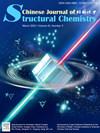Graphene quantum dot modified Bi2MoO6 nanoflower for efficient degradation of BPA under visible light
IF 5.9
4区 化学
Q1 CHEMISTRY, INORGANIC & NUCLEAR
引用次数: 0
Abstract
Graphene quantum dots (GQDs) are a novel type of carbon dot material that has significant application value in the field of catalysis due to their non-toxic, stable, abundant surface functional groups, and quantum confinement effects. A unique composite photocatalyst was constructed by modifying GQDs onto Bi2MoO6 (BMO) microsphere-shaped nano petals using simple hydrothermal and sintering techniques. The structural and morphological characterization results indicate that GQDs with the size of 10 nm are well dispersed on BMO nanosheets, forming close contacts, which can greatly improve the separation efficiency of photo-generated electron-hole pairs under visible light irradiation. In the evaluation of the catalytic performance of BPA solution (20 mg/L) with a catalyst content of 20 mg under a simulated light source with a power of 300 W, the best degradation performance was achieved by a photocatalyst (G6/BMO) with the GQDs mass ratio of 6%, which degraded over 95% of BPA under visible light within 120 min, while pure BMO only degraded about 45% of BPA during the same time period. Even if the 400 nm filter is removed and directly exposed to Xe lamp radiation, the degradation performance of the optimal composite catalyst is only slightly improved, indicating that the current GQDs/BMO composite catalyst has extremely strong visible light catalytic activity. The improvement of catalytic performance comes from the effective separation of electron-hole pairs caused by the absorption of electrons by GQDs, and the introduction of GQDs to reduce the band gap and enhance visible light absorption, both of which are beneficial for catalytic reactions. Free radical capture and electron spin resonance (ESR) tests indicate that ·OH and ·O2− are the main active species for BPA degradation. Although the current GQDs/BMO catalysts have a simple structure, their catalytic performance has significantly improved, which will guide the design of other semiconductor based photocatalysts.

求助全文
约1分钟内获得全文
求助全文
来源期刊

结构化学
化学-晶体学
CiteScore
4.70
自引率
22.70%
发文量
5334
审稿时长
13 days
期刊介绍:
Chinese Journal of Structural Chemistry “JIEGOU HUAXUE ”, an academic journal consisting of reviews, articles, communications and notes, provides a forum for the reporting and discussion of current novel research achievements in the fields of structural chemistry, crystallography, spectroscopy, quantum chemistry, pharmaceutical chemistry, biochemistry, material science, etc. Structural Chemistry has been indexed by SCI, CA, and some other prestigious publications.
 求助内容:
求助内容: 应助结果提醒方式:
应助结果提醒方式:


